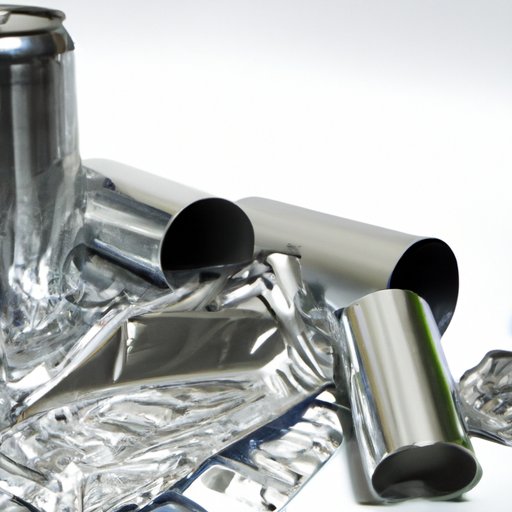Introduction
Aluminum recycling is an important practice that helps reduce waste, conserve energy, and protect our environment. In this article, we’ll explore what aluminum recycling is, how it works, and the benefits it provides for us and our planet.

Exploring the Science Behind Aluminum Recycling
Before we dive into the specifics of aluminum recycling, let’s take a look at what aluminum is and why it’s so easily recycled.
What is Aluminum?
Aluminum is a lightweight metal that is abundant in nature. It’s the third most abundant element in the Earth’s crust, after oxygen and silicon. It’s also easy to work with, durable, and resistant to corrosion, making it a popular choice for consumer products.
Properties of Aluminum that Make it Easy to Recycle
Aluminum has several properties that make it an ideal material for recycling. First, it’s lightweight and malleable, making it easy to transport and shape into new products. Second, it’s non-toxic, meaning it doesn’t release any harmful chemicals when recycled. Finally, aluminum is 100% recyclable, meaning it can be reused over and over without losing any of its properties.
How Does Aluminum Get Recycled?
Recycling aluminum starts with collecting and sorting the material. Once it’s been collected, it’s then transported to a recycling facility where it’s melted down and turned into ingots. These ingots are then shipped off to manufacturers who use them to create new products.

How to Properly Recycle Aluminum for Maximum Efficiency
Now that you have a better understanding of how aluminum recycling works, let’s take a look at the steps you can take to ensure your aluminum is recycled properly and efficiently.
Steps for Collecting, Sorting, and Preparing Aluminum for Recycling
The first step in recycling aluminum is to collect and sort the material. This involves separating aluminum cans, foil, and other items from other types of waste. Once the aluminum has been separated, it should be rinsed and cleaned before being placed in a designated recycling container.
Types of Containers Used for Aluminum Recycling
Once the aluminum has been sorted and prepared for recycling, it needs to be placed in a suitable container. Most municipalities provide large recycling bins specifically for aluminum cans and other containers. In addition, many businesses and organizations have their own designated aluminum recycling bins.

The Benefits of Aluminum Recycling for the Environment
Aluminum recycling offers numerous benefits for the environment. Let’s take a look at some of the ways it can help protect our planet.
Impact on Carbon Emissions
Recycling aluminum is an effective way to reduce carbon emissions. Producing new aluminum from raw materials requires a lot of energy, which produces carbon dioxide. By recycling aluminum, we can reduce the amount of energy needed to produce new aluminum, thus reducing carbon emissions.
Reduction of Landfill Waste
One of the biggest benefits of aluminum recycling is that it reduces the amount of landfill waste. When aluminum is recycled, it’s melted down and reused to make new products instead of ending up in landfills. This helps to conserve resources and reduce pollution.
The Economic Advantages of Recycling Aluminum
In addition to the environmental benefits, aluminum recycling also offers economic advantages. Let’s take a look at some of the ways it helps the economy.
Cost Savings in Energy and Resources
Recycling aluminum can save money by reducing the need for energy and resources. For example, producing new aluminum from raw materials requires a lot of energy, which is expensive. But when aluminum is recycled, less energy is needed, resulting in cost savings.
Creation of New Jobs
Recycling aluminum creates jobs. Collecting, sorting, and preparing aluminum for recycling requires workers, and the production of new products from recycled aluminum requires even more workers. This helps to stimulate the economy and create new job opportunities.
What Happens to Aluminum During the Recycling Process?
Once the aluminum has been collected and sorted, it goes through several steps before it can be turned into new products.
Melting Down Aluminum Cans
The first step in the recycling process is to melt down the aluminum cans. This is done in a furnace at high temperatures, which causes the aluminum to liquefy. The molten aluminum is then poured into molds to form ingots.
Refining and Purifying the Aluminum
Once the aluminum has been melted down, it must be refined and purified. This involves removing impurities such as plastic, paper, and other materials that may have been mixed in with the cans. This ensures that only pure aluminum is used to make new products.
Making New Products from Recycled Aluminum
Once the aluminum has been refined and purified, it can be used to make new products. This could include anything from aluminum cans and foil to car parts and building materials.
Conclusion
Aluminum recycling is an important practice that helps reduce waste, conserve energy, and protect our environment. It also offers economic advantages, such as cost savings in energy and resources and the creation of new jobs. We hope this article has helped you understand the importance of aluminum recycling and how it works.
By recycling aluminum, we can all do our part to reduce our impact on the environment and help create a sustainable future.

